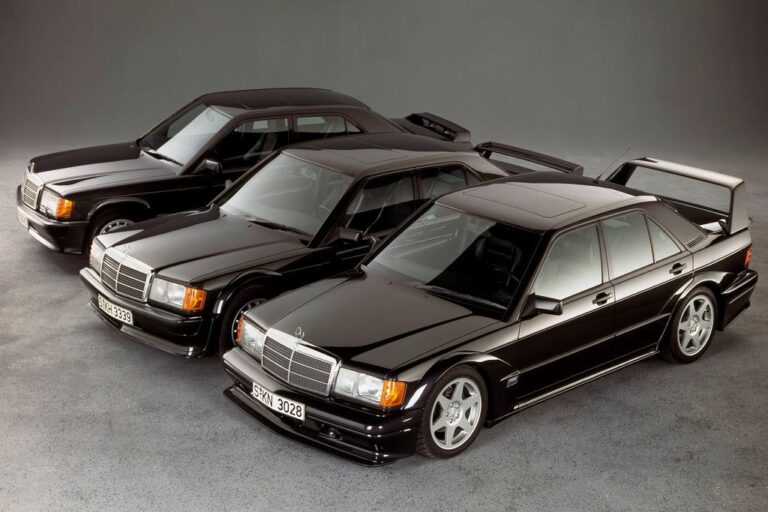
Well,
that’s how it was until it all suddenly changed when a new baby-Benz arrived.
As with all new babies, the new arrival changed the Mercedes family forever.
The all new Mercedes 190 (W201) first saw the light of day in 1982. Born in
December of that year, the Christmas baby looked strikingly similar to its
older siblings. Outwardly, there was nothing particularly revolutionary about
this new addition, it just fitted in rather well. The Benz family seemed to
carry on quietly and contentedly with their lot.
However,
the new baby-Benz 190 “compact class” became quite the milestone for
the Mercedes family of cars. The model became a new benchmark for the future
development of the Mercedes model range. The 190’s styling clearly matched that
of its bigger siblings. This was a clear hint to 190 owners who might have been
feeling a little bit reticent about their newfangled bijou Benz. The familiar
styling was a cue that clearly signalled that 190 drivers were indeed sitting
behind the wheel of a genuine pure-bred Mercedes. A marque that embodied the fine
art of progress.

With its
clearly defined Mercedes credentials, there was nothing reticent about the new
model. The 190 comfortably took its place amidst the Mercedes family. The first
models (the 190 and 190E) swiftly became a major success story. The 190
provided firm foundations for the subsequent C-Class (compact class). From
concept, the venerable 190 baby-Benzes clearly aimed to replicate all the
virtues of their larger siblings especially when it came to matters of
handling, safety and bulletproof reliability. All these well-honed
Mercedes-Benz traits were now beautifully presented in bite-sized form,
providing a light Mercedes-Benz that proved to be as excellent as it was
economical. This was a real game changer. An everyday luxury Mercedes that was
beautifully designed, superbly crafted yet attainable.
To reduce
fuel consumption, Mercedes engineers had created a surprisingly aerodynamic
body considering its somewhat angular outward appearance (compared to modern
cars). Mercedes also used high-strength sheet steel alongside numerous other
innovative materials to help reduce overall weight. The 190 weighed less than
1200kg without compromising safety. Other safety elements were taken from the
flagship S-Class, meaning that the 190 was a small, user-friendly saloon that
came without any compromises.
The 190
boasted a brand-new chassis design which was specifically developed for the
all-new model. The setup featured multi-link independent rear suspension which
helped improve steering precision and ensured sure-footed handling
characteristics. Modernised front and rear axles also meant superb stability
ensuring the baby-Benz had some very grown-up road manners.

With road
manners and agility assured, the 190 had plenty of other satisfying traits up its
sleeve. These traits would delight even the most ardent Benz aficionados. For
those lucky enough to have become accustomed to driving the likes of an S-Class
or a mid-size Mercedes, familiarity reigned supreme as soon as they stepped
into the 190’s cockpit. Quality materials, familiar switchgear and typically
Mercedes instrument layouts all made the 190 a reassuring addition to the
Mercedes-Benz family.
Production
of the 190 and 190E models began in 1982. The two initial models both featured
2.0-litre, four cylinder petrol engines. Later on, 190E models boasted
significantly more power thanks to the introduction of petrol injection (EFi).
This was yet another Mercedes milestone because it was the first time that
their engineers had used the mechanical electronically-controlled Bosch
KE-Jetronic injection system in any of their cars. This gave the 190E a top
speed of nearly 122-mph and the kind of spirited performance befitting the
three pointed star.

A year
later, the Mercedes 190D was introduced. This model featured a newly developed
2.0-litre four-cycle diesel engine. The buying public were utterly fascinated
by this exceptionally powerful yet remarkably refined diesel power plant. Known
as the Mercedes “whisper diesel,” the new engine produced less than
half the noise of rival makers’ diesels. The meticulously engineered silence
was further enhanced by exceptional levels of sound deadening. This amazing new
diesel engine heralded future development of further groundbreaking,
state-of-the-art diesel technology in future Mercedes-Benz passenger cars. Low
fuel consumption and respectable power delivery proved to be a highly
successful combination amidst both private and fleet buyers.
The 190
“compact series” was certainly an overwhelming success story. 1984
brought us yet another incarnation of the 190E. This time it was to come in the
guise of the 2.3-16 190E. This new sporty model was another very clear departure
featuring the looks of a compact sports saloon. It even had a wing-type spoiler
on the rear. The 2.3-litre four-cylinder engine came with a newly designed
cylinder head with two intake valves and two exhaust valves. Alongside other
modifications, power was significantly boosted, providing a 0-60 time of just
7.5 seconds. The car’s top speed was in excess of 142mph which was an
astonishing figure by any standards. Spritely diesels weren’t forsaken either.
In 1987, Mercedes brought out the 190D 2.5 Turbo. This time the engine was a
122-horsepower five-cylinder turbo diesel delivering a top speed of 120-mph
with an equally impressive 0-60 time of 11.5 seconds. The powerful turbo diesel
variants were easily distinguished by stylish body embellishments and twin
exhaust outlets.

During an
illustrious eleven year production run (1982-1993) various improvements and
design tweaks were made to keep the 190 model fresh and interesting to the
buying public. As a run-out exercise, in 1992, Mercedes-Benz presented three
special models of the 190. They were branded “Avantgarde” versions of
the 190E 1.8, 190E 2.3 and the 190D 2.5 turbo diesel. These models had a more
up-to-date appearance which created a more fresh and youthful style. The
models were available in special paint finishes. But, production of the W201
ended in 1993. In all, 1,879,629 had been made during this period. The success
of the compact Mercedes (or the baby-Benz) was assured. Mercedes had
successfully managed to extend its branding into another segment of the market
and by so-doing they’d created an absolute icon.